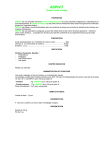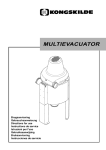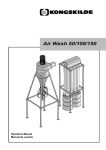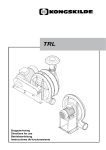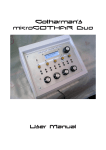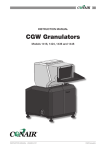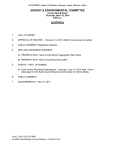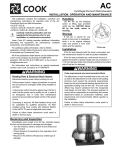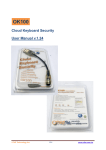Download English
Transcript
POLYVAC Directions for use POLYVAC 30/50 - Standard units with Gaylord height stand and dust collection Fig. 1 Assembly Instructions Standard units with Gaylord height stand and dust collection All instructions refer to Figure 1 on page 2 For proper assembly, follow steps listed below. a: Mount the Polyvac unit (1) on the stand (2) using U-bolts (13), flat washers (14) and lock nuts (15). Make certain that the foundation is secure, and check regularly that all the mounting bolts are tight. b: Attach the filter manifold support arm (3) on the stand (2). c: Attach first the OK160/200 transition (10) to blower outlet with OK160 clamp (12). Then mount 45° bend (8), OK200 pipe (9), and again a 45° bend (8) using OK200 clamps. Attach the 4 bags manifold (4) on the support arm and clamp it to the bend (8). d: Place drum (7) with lid (6) under the 4-bag manifold and installs the four filter socks (5). The filter socks are slid over the OK adapters on drum lid and manifold and secured with OK200 clamps. Make sure there is approximately 1 inch of material slid through the clamp. List of Equipment 15 8 600366003 5/16" Lock-nut 14 8 100331014 M8 Flat Washer - Plated 13 4 600373028 5/16" x 2-1/2" x 60mm U-bolt 12 1 122000800 OK160 Quick Release Clamp, galv. 11 12 122050101 OK200 Quick Release Clamp, grey 10 1 121000367 OK160/OK200 Transition, grey 9 1 122000455 OKD200 x 0.15m Pipe, grey 8 2 122050115 45" OK200 Bend, galv. 7 1 699114492 45 Gallon Drum w. Window 6 1 699114237 4 x OK200 Inlet Drum Lid. 5 4 699114055 OK200 x 2m Filter Sock 4 1 699114441 4 Bag Manifold w. Side Inlet 3 1 699115792 Polyvac 4 Bag Manifold Bolt-on Stand 2 1 699115160 Polyvac Stand 1d 1 123110003 Polyvac 50, 5hp, 3ph, 575V-60Hz 1c 1 123110002 Polyvac 50, 5hp, 3ph, 460V-60Hz 1b 1 123110001 Polyvac 30, 3hp, 3ph, 575V-60Hz 1a 1 123110000 Polyvac 30, 3hp, 3ph, 460V-60Hz POLYVAC 30/50 - Standard Units with Suction Flexhose Fig. 2 Assembly Instructions Standard Units with Suction Flexhose All instructions refer to Figure 2 on page 4 a: Rotate the Cyclone Inlet (Item A) for the best working position of the Suction Flex hose. Loosen, but do not remove, the clamps on both top and bottom of the cyclone. Rotate the cyclone to the desired position, retighten the clamps. b: Install the 4" Suction Flex hose. (Item C) First the OK160 (6") to OK100 (4") adapter (Item B) must be clamped to the cyclone. The Flex hose is then connected with the OK100 (4") quick clamp. c: Install the Suction Wand (Item D) to the Flex hose. Make sure the air intake and handle are located at the end nearest the hose. POLYVAC 30/50 - SUC Unit Fig. 3 Assembly Instructions SUC Unit For proper assembly, follow steps below. See Figure 3, Page 6. 3: Mount the telescopic pipe between the elbows adjusting the pipe to the desired length. Secure both ends with the pipe clamps. Slide the rubber O'Ring down the pipe until it rests on the other pipe lip. Place the pipe clamp around O'Ring and the pipe lip, and secure clamp. 4: a: Attach the 4 leg extensions (Item A) to the bottom of the POLYVAC stand. Requires 16, 1/4 x 3/4" bolts. b: If the POLYVAC unit is to be mobile, attach the 4 optio- j: Install electrical power to the motor. Follow electrical nal caster wheels (Item B). Requires wiring instructions on the inside of motor electrical box. 4, 1/4 x 3/4" bolts. Note: Make sure the motor is turning in the c: Mount the Blow Through Unit (Item C) on the bottom of proper direction as shown by the the arrow on the Rotary Valve (Item D). Requires the fan housing. 4, 5/16 x 2" bolts. All electrical work must comply with local d: Mount the POLYVAC unit in a suitable location using the regulations. bolt plate on the legs of the stand. Make certain that the foundation is secure, and check regularly that all mounting bolts are tight. e: Rotate the Cyclone Inlet (Item E) for the best working position of the Suction Flex hose. Loosen, but do not remove, the clamps on both top and bottom of the cyclone. Rotate the cyclone to the desired position, and retighten the clamps. f: Attach the Variable Air Intake (Item F) to the Cyclone with OK160 (6") clamp. g: Install the 4" Suction Flex hose. (Item H) Clamp the OK160 (6") to OK100 (4") adapter (Item G) to the variable air intake. Then connect the Flex hose with the OK100 (4") clamp. h: Install the Suction Wand (Item I) to the Flex hose. The air intake and handle are locate at the end nearest the hose. i: Install the Intermediate Piping (Item J to L) between the Fan outlet and the Blow Through Unit. 1: Attach the 90° Degree (Item J) elbows to the Fan outlet and to the Blow Through using the clamps. 2: Slide the telescopic pipe with rubber O'Ring (Item K) inside the 12" pipe (Item L). Note: The seams of the pipe must be aligned for proper function of the telescopic pipe. Operation of POLYVAC Standard Unit a: When using the POLYVAC to draw material from gaylords, bin, etc., a certain amount of air is required in the pipe to keep the material fluidized. This secondary air is allowed in by adjusting the air intake (Item G) on the Suction Wand (Item D, Page 4). intake (Item M) on the Suction Wand (Item I) and on the Variable Air Intake (Item F, Page 6). Initially set both air intakes half way open. No. 5) Note: By closing the intake, the conveying capacity is increased. By opening the intake, the conveying capacity is decreased. By closing the intake, the conveying capacity is increased. Note: Do not close off intake too far as material will stop flowing and lay in the hose. Material must continue to flow. b: Start up the system. Insure that the end of the Suction Wand does not become plugged with foreign material or become blocked by the sides or bottom of the bin. By opening the intake, the conveying capacity is decreased. b: Insure that the end of the Suction Wand does not become plugged with foreign material or become blocked by the sides or bottom of the bin. Note: Large foreign objects entering the wand may plug and damage the Rotary Valve. C: Check filter(s) regularly for build up. Clean as required. Restriction of air flow through the filter will reduce capacity. (Item 5, Page 2) d: Check the inside of the cyclone periodically for build up on the screen. Simply remove the clamp holding the fan housing and the suction cyclone together. The fan housing is spring loaded and will raise easily out of the way. Restriction of air flow through the cyclone screen will reduce capacity. Note: Do not operate the POLYVAC with the fan housing raised. Insure the finger guard is in place at all times. Exposed fan rotor may cause serious injury. Operation of POLYVAC SUC Unit a: When using the POLYVAC to draw material from gaylords, bins, etc., a certain amoumt of air is required in the pipe to keep the material fluidized. This secondary air is allowed in by adjusting the air Note: Large foreign objects entering the wand may plug and damage the Rotary Valve. c: With the Suction Wand in the material, adjust the air intake on the wand just to the point where material starts to plug in the flex hose. Now open it up slightly. If more capacity is required adjustments can also be made on the Variable Air Intake. d: The variable air intake can be closed slightly, thus reducing the amount of air entering the system at this point. Caution must be used as closing this intake too much will result in the transfer piping plugging. (ie. not enough air to carry the product) This plug will usually occur at a 90° degree elbow heading vertical. The amount of secondary air required to enter the system is dependent on the density and size of the particles being transported, along with the piping configuration within the system. Some experimentation will be required for each system to optimize the capacity. e: Check the inside of the cyclone periodically for build up on the screen. Simply remove the clamp holding the fan housing and the suction cyclone together. The fan housing is spring loaded and will raise easily out of the way. Restriction of air flow through the cyclone screen will reduce capacity. Note: Do not operate the POLYVAC with the fan housing raised. Insure the finger guard is in place at all times. Exposed fan rotor may cause serious injury. Maintenance a: Clean the screen in the cyclone regularly. Open the clamp between the fan and the cyclone. Raise the fan housing up. Using an air hose or small brush remove any foreign material from the screen. This material will then be discharged through the rotary valve. Note: Lock off electrical power before raising the fan housing. Do not operate the unit with the fan housing raised. b: Clean or replace the filter sock(s) regularly. Tap the filter lightly to remove the dust or material allowing it to fall to the bottom. When the build up of material is sufficient, remove the filter and clean completely. c: Check paddle adjustment in the Rotary Valve. Paddles should just contact the wall of the rotary valve. If there is a gap between them, loosen the screws and slide the paddle outwards until it contacts the wall. Retighten the screws. If the paddles are too tight against the wall, the rotary valve will take too much power to operate, or may stop turning altogether. If there is too much gap between the paddles, on the SUC unit the air pressure used below to convey the material will blow back into the cyclone. This will cause reduced conveying capacity and possible plugging in the transfer lines. Troubleshooting Problem Cause Remedy Loss of capacity. Plugged screen in suction cyclone. Clean out screen by means of compressed air and/or steel brush. Paddles in rotary valve leaking. Loosen the screws and slide the paddle outwards until it contacts wall. Retighten the screws. If paddles must be replaced. Follow instructions in the Rotary Valve manual to remove the cell wheel and install new paddles. At this time the bearings should be checked. Rotary Valve not working. Plugging of pressure line - (SUC Unit). 10 Motors are rotating in wrong direction. Change wiring for motor to run in proper rotation on both the fan and the rotary valve. Exhaust filter(s) plugging up. Clean or replace filter socks. Paddles too tight against housing. Loosen the screws and slide the paddle away from the housing. Paddles should just contact the wall. Retighten the screws. Rotor in valve jammed with foreign material. Loosen the clamp between the fan housing (Item H, Page 2) and the cyclone (Item A) and raise the fan housing up. Loosen the clamp on the bottom of the cyclone and remove the cyclone. The rotary valve is now exposed. Remove any foreign material blocking or plugging the valve. Rotor bearings seized. Remove the end caps and replace as outlined in the Rotary Valve service manual. Not enough air being introduced to convey material when going into 6" line from 4" suction line. Open the Variable Air Intake (Item F, Page 6) until material flows freely. Dimensions Specifications Model 30 50 Motor 3 hp 3500 rpm 5 hp 3500 rpm Frame 182T 184T Phase33 Voltage Fan Rotor 460/575 3500 rpm 360 mm dia. on one stage centrifugal 3500 rpm 415 mm dia. on one stage centrifugal RF 20 RF 20 Weight w/o 80 lbs motor and rotary valve Rotary valve type Rotary valve Motor Hose & Nozzles 460/575 0.5 hp 1725 rpm 4" Poly 100 lbs 0.5 hp 1725 rpm 4" Poly 11 123 110 077 18.07.06












